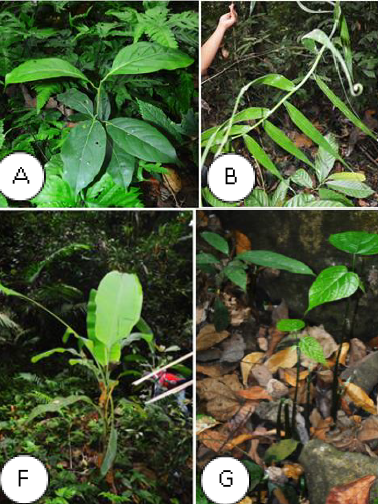Plants Collection Enrichment of Purwodadi Botanic Garden Through Exploration in Alas Purwo National Park

Downloads
Purwodadi Botanic Garden (KR Purwodadi) is an exsitu conservation institution for dry climate lowland plants aiming at saving and protecting biodiversity from extinction. In supporting exsitu conservation efforts, plant exploration activities in their natural habitat need to be carried out. Alas Purwo National Park has a lowland forest area with abundant plant diversity. In addition to functioning as a conservation forest, this area is also a natural and religious tourist attraction, so it is likely to undergo ecosystem damage. Therefore, this plant diversity study with theactivity of plants exploration and collection was carried out for the purpose of ex situ conservation in KR Purwodadi.This study was conducted in August to September 2019 using an explorative method. A total of 24 species were obtained, of which 8 species were not yet cultivated by KR Purwodadi. Besides, there were 5 species included in the IUCN red list, namely Aglaonema simplex, Brucea javanica, Cycas rumphii, Melanolepis multiglandulosa, and Musa acuminata. This study has increased the number of plant collections in KR Purwodadi and contribute positively to the comprehensiveness of plant species data in Alas Purwo National Park.
Allen, D.J. (2011). Aglaonema simplex. The IUCN Red List of Threatened Species 2011: e.T194792A8902274. Diambil tanggal 18 Maret 2020 di www.iucnredlist.org.
BAPPENAS. (2016). Indonesian biodiversity strategy and actionplan (IBSAP) 2015-2020. Jakarta.
Botanic Gardens Conservation International (BGCI) & IUCN SSC Global TreeSpecialist Group. (2019). Melanolepis multiglandulosa.The IUCN Red List of Threatened Species2019: e.T145371691A145371693. Diambil tanggal 18 Maret 2020.
Chen,P., Chen, L., & Wen, J.(2011). The first phylogenetic analysis of Tetrastigma(Miq.) Planch., the Hostof Rafflesiaceae. Taxon,60(2),499–512.
Diartika, E.I.A., Sudrajat, A.K., Indrayanti, A.N., Wahyuhingtyas, D., Rochmah, D.N., Aziza, D.A.N., & Ardy, F.A. (2018). KeanekaragamanTumbuhan di Taman Nasional Alas Purwo, Banyuwangi. Prosiding Seminar Nasional Biologi2018. Universitas Negeri Surabaya. Surabaya, Februari 2018.hal.490-495.
[GBIF] Global Biodiversity Information Facility. (2020).TetrastigmaPlanch.Diambil tanggal 20 Maret2020.
Govaerts, R., & Frodin, D.G. (2002). World checklist and Bibliographyof Araceae (and Acoraceae): 1-560. The Board of Trustess of the Royal Botanic Gardens, Kew.
Heywood,V.H. (2010). The role of botanic gardens as resource and introductioncenters in the face of global change. Biodivers. Conservs.,20, 221–239.
Hidayat,S. (2008). Struktur, Komposisi dan Status TumbuhanObat di Kawasan Hutan Taman Nasional Alas Purwo. Jurnal Biologi,12(1),9–13.
Hill, K.D. (2010). Cycas rumphii.The IUCN Red List of Threatened Species2010: e.T42081A10623127. Diambiltanggal 18 Maret 2020.
IUCN. (2020). The IUCN Red List of ThreatenedSpecies. Version 2020-1. Diambil tanggal 18 Maret 2020.
Kebun Raya Purwodadi. (2020). Status Tanaman. Purwodadi, Indonesia: KoleksiTanaman. Diambil tanggal 26 Februari 2020.
Kusuma, Y.W.C., Dodo, & Widyatmoko, D. (2008). Koleksi Tumbuhan TerancamKepunahan di Kebun Raya Bogor. Buletin Kebun Raya Indonesia, 11(2), 33–45.
Liu, B., Botanic Gardens Conservation International(BGCI), &IUCN SSC Global Tree Specialist Group. (2019). Brucea javanica.The IUCN Red List of Threatened Species2019: e.T88319896A147617680. Diambil tanggal 18 Maret 2020.
Murphy,G.E.P.,& Romanuk,T.N. (2014). A meta-analysisof declines in local species richness from human disturbances. Ecol. Evol.,4, 91–103.
Oldfield,S.F. (2009). Botanic gardens and the conservationof tree species. Trends in Plant Science,14, 581–583.
The Plant List. (2013). Version 1.1. Published on the Internet. Diambil tanggal 18 Maret 2020.
Wen, J., Nie, Z.L., Soejima, A., &Meng, Y. (2007). Phylogenyof Vitaceae based on the nuclear GAI1 gene sequences. Canad. J. Bot., 85, 731–745.
Widyatmoko. (2019). Strategi dan inovasi konservasi tumbuhan Indonesia untuk pemanfaatansecara berkelanjutan. Seminar Nasional Pendidikan Biologi dan Saintek. Program Studi Pendidikan Biologi Universitas Negeri Surakarta. Surakarta, 27 April 2019.
Williams, E. (2017). Musa acuminata.The IUCN Red List of Threatened Species2017: e.T22486320A22486950. Diambiltanggal 18 Maret 2020.




